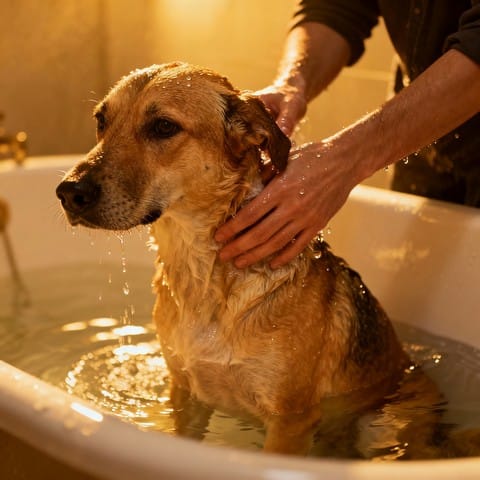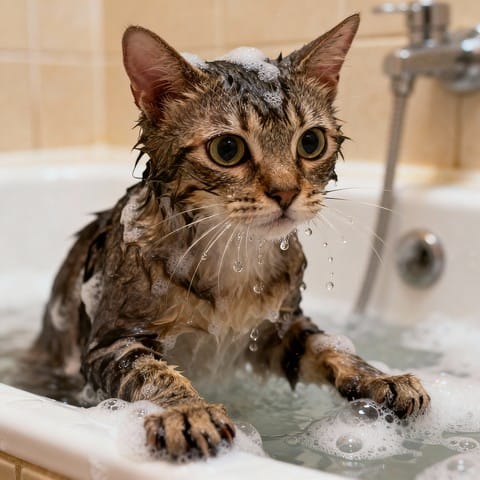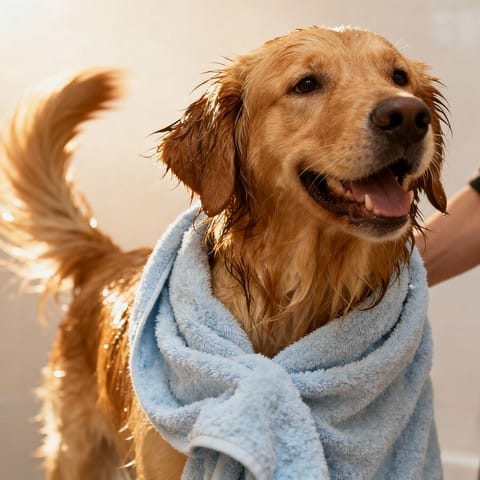If you are a proud pet parent, and we bet you are and, that is why you are here at Dreamy Mammals, there must be one thing you get annoyed a lot. Yes, we are talking about the bathing time for your pet and how your pet hates it to the core! For most of the pet parents – be it dog owners or cat lovers, the bathing time is a time for a battleground in itself.

So, why do pets have nath time anxiety and how can you transform the important routine a pleasurable experience for your pet? Well, there are several ways you can strengthen the bond between you and your furry friend while making sure that your pet is healthy and clean.
Why Your Pet Hates Bath Time?
Well, there are multiple reasons that makes the pets have anxiety about bath time.
Physiological stress response
Studies have shown that dogs go through a steep rise in their heart rate and respiratory rates during the bathing and drying phases. it is understood that they are not familiar with the bathwater and the pressure from the blow dryers. this creates stimulus that manifests itself in the form of physiological changes.
-
Heart rate increases during bathing and drying phases
-
Elevated cortisol levels indicate stress response activation
-
Behavioral signs include panting, whining, and attempts to escape
-
Physical symptoms may include excessive drooling and trembling
You may also be interested in –
Common Triggers that create Bath time anxiety
Understanding the key triggers should help you address the specific concerns that your pet may have. Instead of managing the symptoms, we at Dreamy Mammals believe that addressing the root cause makes more sense.
- Sensory Overload – There are many things in the bathrooms that may overwhelm your pet. The sound of running water, the smell of shampoos and soaps, the pressure from the sprays that may cause strange sensory perceptions – the list may be endless.
- Loss of Control – You might have seen dogs swimming. But, that is a voluntary action. When bathing, your pet may feel loss of control. They may begin to feel that they are trapped in an unfamiliar situation. This will result in stress symptoms and triggers.
- Slippery Surface – Most of the pets find it difficult to maintain footing on wet surfaces. As they attempt to stabilise themselves, they face muscle tension. This kind of physical discomfort adds to the anxiety.
- Temperature sensitivity – The temperature tolerance considerably differs from humans to the pets. What feels comfortable to use may be too warm for the pets. The temperature requirements for the dogs and cats differ considerably.
Species Specific Stress Response
Dogs and cats are not similar when it comes to their responses. You need to understand the exact response they show to similar stress triggers.
Why Dogs React Differently Than Cats?
Both cats and dogs have a different evolutionary background. Dogs have been known to exhibit overt stress signals. They manifest their stress through vocalisations like barking and whining. You may also find them showing signs of an escape attempt.
-
Whining, barking, or growling as communication attempts
-
“Whale eye” appearance (showing white sclera around pupils)
-
Tucked tail and lowered body posture
-
Excessive panting and drooling
-
Attempts to jump out of the tub or hide
Dogs are more social than cats. That is why they show overt stress signals. They look up to their human companions when they are in uncertain conditions.
Cats, on the other hand, show very subtle stress signals. Cats generally freeze and become still when they are stressed out. This can indeed be misleading. Many of the cat owners think that their cat is quite cooperative when grooming.

-
Flattened ears and tense facial muscles
-
Dilated pupils and rapid blinking
-
Excessive vocalization or complete silence
-
Rigid body posture or “freezing” behavior
-
Excessive grooming after the bath
How to Create a Positive Bath Environment for Your Pet – Step by Step Guide
You can employ a few strategies to make sure that your pet is not stressed out during the bathing schedule.
Pre-Bath Preparation Strategies
You can consider desensitising your pet so that it does not get stressed out during bathing.
- Environmental setup – Create a positive atmosphere that reduces pet anxiety. Choose a location away from chaos or noise. You can consider soft music or white noise to block the uncomfortable noise.
- Familiarise with the tools – Let your pet investigate the grooming tools on their own. Place treats near towels, brushes, and shampoo bottles, letting curiosity replace fear. This process builds familiarity without pressure.
- Exercise before bathing – An exhausted pet is always a calmer pet. The Journal of Veterinary Behavior suggests 15-20 minutes of exercise before grooming can significantly reduce anxiety levels. This approach helps burn excess energy that might otherwise manifest as stress-driven behavior.

Professional groomers have developed what’s known as the “3-3-3 Rule” for optimal bathing experiences:
-
3 minutes of pre-bath preparation: Gather supplies, adjust water temperature, and allow pet exploration
-
3 main washing cycles: Wet thoroughly, shampoo gently, rinse completely
-
3 minutes of post-bath reward time: Positive reinforcement and comfort measures
Common Mistakes to Avoid
There are a few mistakes that may make the bathing time more stressful for your pet. Avoid these mistakes so that your cat or dog is not overwhelmed.
Never rush the process
Many pet owners rush through the bathing process. However, research states that hurried bathing sessions should always be avoided. It can indeed create higher anxiety levels. Professional groomers recommend allowing adequate time—often an hour or more—to proceed at the pet’s pace.
Do not use inappropriate products
Human shampoos and products should never be used on pets due to pH differences between human and animal skin. Cats particularly require shampoos formulated specifically for felines, as their skin has different thickness and acidity levels compared to both humans and dogs.
Do not ignore stress signals
Failing to recognise and respond to pet stress signals can escalate anxiety and create lasting negative associations with bathing. Learning to read your pet’s body language allows for real-time adjustments that prevent bath time from becoming traumatic.
Conclusion
It is not too difficult to transform the bath time experience for your pet from a stressful ordeal into a calm bonding experience. However, it involves building trust, ensuring health, and strengthening the bond you share with your furry companion. Understand this first – pets experience genuine physiological stress during bathing, but with proper techniques and patience, we can significantly reduce their anxiety while maintaining their hygiene needs.
Your patience and dedication to making bath time a positive experience reflects the deep care you have for your pet’s comfort and happiness. Every small victory—whether it’s your dog staying in the tub without struggling or your cat tolerating water without hissing—is a step toward a lifetime of easier grooming experiences. With time, consistency, and the right approach, bath time can evolve from your pet’s least favorite activity into a routine they approach with calm acceptance, knowing they’re safe in your caring hands.




Add Comment